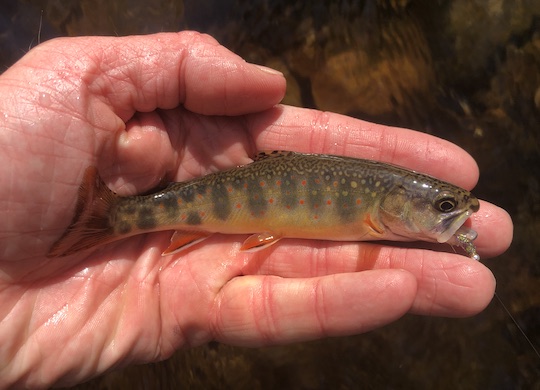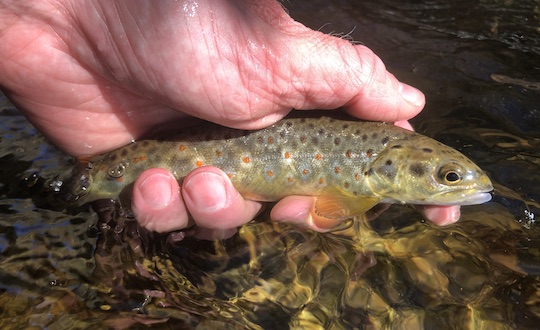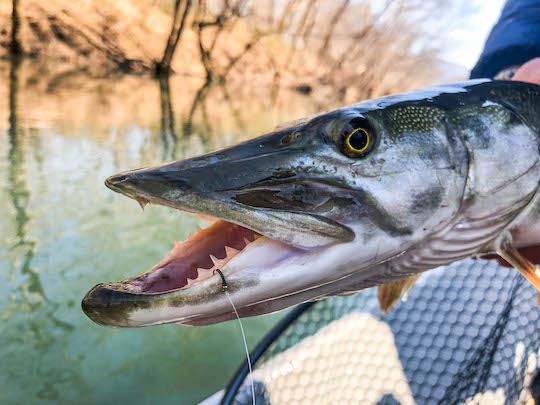Each angler has a growth timeline, and everyone's is different. Most likely, the pattern is not linear, but rather includes growth in fits and starts and maybe even some regression. For example, you probably weren't a proficient caster when you first started into the sport. Over time, you learned a basic cast, then maybe something fancier like a reach cast, parachute cast, steeple cast, well, you get the idea. There is a lot of growth that happens as a fly angler if you are spending much time doing it.
The Beginning
Most of us started our journey of growth with that first trout on a fly rod. I remember mine just like it was yesterday. My dad had taken me fishing in the Smokies and I was trying my best to figure out how to catch a trout. The shiners were easy, and I had caught plenty of those. Same for the chub and other small minnows. What I wanted was a real, honest to goodness trout.
We were fishing the lower end of Anthony Creek or the upper end of Abrams Creek depending on your definitions. I generally consider Anthony Creek to be the main stream in the upper part of Cades Cove before the water goes underground and Abrams Creek to be the downstream portion where it reemerges at several large springs. We were fishing just below the road crossing on Sparks Lane. A small cuttbank had helped scour a deeper hole in the creek where the water turned hard. At the bottom, I saw what looked like a rainbow trout.
Sure enough, after tying on a small nymph, I got the cast angle right and the fly drifted down to the fish. Immediately, the trout inhaled the fly, and I set the hook. Soon, I was holding my first wild rainbow trout. That moment is something I enjoy reliving again and again as a fly fishing guide. Watching people start the journey as a fly angler is one of the treats of my job. Then again, the whole job is more or less a treat.
First Nice Brown Trout
I also remember my first quality brown trout in the Smokies. Not too long after that memorable rainbow, I was back fishing in the Smokies again. My dad was kind enough to take me fishing even though he wasn't himself fishing. These trips were a big treat, and contributed greatly to me being the angler I am today. Without those early trips, I probably would never have become a fly angler, much less been able to make it a career.
Anyway, it was late in the day. My dad was tired and had stayed up at the car to probably catch a snooze while I wandered down through the woods to the bank of Little River. A perfect run had a big rapid dumping in from above. The big pocket where the rapid dumped in was separated from the main pool, but it looked fishy. I could just imagine the big trout waiting for me there.
At that point in my angling career, I still was nowhere close to proficient with nymphs. Nowadays, that is probably what I would have been fishing. Thankfully, perhaps, because a big dry fly is what grabbed the attention of the big brown trout. I had tied on a big yellow Stimulator. High sticking it across the first currents and letting it dance across the surface, a big golden blur swirled on it. Once, twice, three times. Surely this fish wasn't going to keep coming back to my fly. And yet it did. One more time was one too many for the fish.
Down into the big pool went the big fish with me in pursuit. When I finally landed it, I looked around, hoping my dad might appear with a camera. No such luck happened, and I carefully slid the hook out and released the quality trout. The fish was probably 16 inches or so. Nowhere close to the largest I've ever hooked, this was still memorable as the first really nice trout I caught on a fly rod.
First Quality Smokies Rainbow Trout
My first big wild rainbow in the Smokies was also memorable. So was the second. Eventually, some of the big fish you catch over the years start to blur together. However, for me at least, some of those early ones were pivotal moments that gave me the motivation to stick with it. They were evidence that I was slowly but surely figuring things out.
The first big wild rainbow trout in the Smokies came on Abrams Creek. The late evening hatches and spinner falls are legendary. I found myself there late one day and was fishing over some rising trout. They wouldn't take what I was throwing. About that time, I noticed bugs skittering up and down just above the water's surface. Occasionally, one would bounce all the way down to the water before flying up again. Now I know that I was witnessing egg laying activity. At the time, I just knew I had to mimic the action of the real bugs.
Extending my rod tip as far out as possible, I bounced it carefully up and down, making my dry fly dance just like the naturals. Sure enough, a big trout leaped and inhaled my fly. The 14 inch wild rainbow was big for the Smokies. I was sure that I was onto something. Catching another couple of fish with a similar technique had me genuinely excited. However, it was a very specific technique with a very specific application. What about when the fish weren't looking for egg layers?
The second quality rainbow sort of snuck up on me. It was in the fall, and I was fishing a favorite pocket water stretch of Little River. To this day, I still like that section, probably because of the style of water which matches my preferred style of fishing. Regardless, water levels were at a normal fall low and a dry fly seemed appropriate. I had tied some October caddis and had one on the end of my leader as I prospected my way upstream. The take was rather nonchalant, but the fight was anything but. The 15 inch wild rainbow trout gave both me and my fly rod a real workout. I think a couple of cars stopped and took pictures of the fight, but I was too focused to be sure of that part. When that fish came to the net, I had my second wild rainbow over 12 inches ever.
This second big rainbow was a pivotal moment because I had caught the fish on a rather lengthy cast compared to my usual high sticking. Normally not as successful with longer casts, this moment convinced me that it was possible to catch fish on longer casts. The line management skills necessary would come with practice.
Fishing With A Guide
My first time fishing with a guide really propelled me forward in my fly fishing journey. In fact, it wouldn't be inaccurate to say that one of the all time biggest contributors to my fly fishing education and growth was thanks to the famous
Walter Babb. I wanted to learn to high stick nymphs without an indicator. Today, the buzzword is euro nymphing. Back when I learned, we didn't have fancy indicator tippet, but the techniques are similar. However, the local technique is something that evolved separately, first using a long cane pole and a fixed length line, then eventually a fly rod.
The general idea is to lead the flies through the water without dragging them. When your leader or tippet ticks or straightens out, you have a bite. There are other things like a tuck cast that help make this all come together, but really it isn't too difficult. However, I was having a hard time figuring everything out. The instruction from a professional guide made all the difference in the world, and my catch rates very quickly went through the roof.
My skills in the Smokies were really coming into their own, but there was still a lot of water out there to learn. Tailwaters, smallmouth, and of course trout streams and rivers out west. My horizons were about to expand in a big way and that would further my growth as an angler.
Sometimes Failure Produces Growth
Interestingly, one of the next major growth moments for me happened almost by accident. Sometimes being in the right place at the right time leads to growth even when you don't catch any fish. This episode happened at Lee's Ferry on the Colorado River below Glen Canyon Dam. After reading about this famous tailwater in Fly Fisherman many years ago, I just had to fish there. When a year off in college took me to Arizona, I knew my opportunity had come.
I stopped at one of the local fly shops, talked to the person there, and ended up buying some
zebra midges. They explained how to fish them, and I headed out to the walk and wade access. In the end, I couldn't buy a trout. The big water of the Colorado both humbled and intimidated me at the time. So, I walked away with some new flies, and a memory of a beautiful river I hope to fish again someday.
Fast forward a few months, and you would find me standing on the banks of Tennessee's
Caney Fork River. As I was thinking about what to fish with, I remembered that somebody had said that Caney Fork was a good midge fishery. Remembering those zebra midges, I dug through my boxes and attached one on a dropper below my dry fly. Amazingly, every fish I cast to ate the zebra midge. To say it was an eye opener would be an understatement. That day on the Caney and that tough day on the Colorado combined to interest me in midge fishing. Now, I fish them year round and am still learning a lot about them each time I go.
My midge fishing has evolved continuously from that day. I've caught fish all over the western US on midges. Of course, my home rivers also fish well with them. Even in the Smokies, I fish midge patterns when the going gets tough.
Ability is the Sum of Experience and Knowledge
As an angler, there have since been many other learning moments. I'll never forget my first time in a drift boat, with many others to follow. Good friends along the way have helped to mold the angler that I am today. At the end of the day, an angler's ability is the sum of their experience and knowledge with maybe a little luck thrown in for good measure. Certainly some of my favorite catches over the years were the result of luck to some extent. At least being in the right place at the right time, but ability still is an important component.
Sometimes, an angler can get in their own way too. I've lost a good many fish over the years. There were fish that I shouldn't have lost. Some were my own fault, probably many in fact. Other times, the fish simply won. Still, a good angler minimizes those times through their vast catalogue of experiences. Other battles won and lost. Other big fish played on light tippets, or maybe other big fish on heavy streamers.
Sometimes even the little guys teach us valuable lessons. I once fished for a 6 inch rainbow in the Smokies for a good 45 minutes without catching it, mostly because I love sight fishing. Still, I learned a lot about what wasn't working on that particular fish. Those big fish are the ones that keep us coming back. I often tell other anglers, both clients and also friends and family, that to land big fish, you usually have to lose a few to figure out how to fight them properly. You can be coached up to a point, yet if guiding has taught me anything, you can be told exactly what is about to happen and still do the wrong thing.
Losing the Bull Trout of a Lifetime
Last summer, on our western road trip, chasing bull trout was part of the goal. I had done my homework. The knowledge piece seemed to be there, but I needed to gain the experience part firsthand. When I hooked and fought a bull trout for probably a minute or more the first day of fishing, I thought I had it made. Seconds later, the fly simply pulled out.
In retrospect, there were at least a couple of things I did wrong as well as a few I did right. First, I was fishing the heaviest tippet I thought I could get away with. That was smart. Turns out the tippet was the least of my worries. This big mean fish didn't care whether I had tied the fly on with rope. Bull trout are generally going to eat or they aren't. If a bull trout is in the mood to feed, I'm of the opinion that just about anything will work based on my very limited experience.
Another thing I did right was to bring as much pressure to bear on the fish when it headed for a big log jam. The big fish turned at the last possible second. Another couple of feet and the fish was undoubtedly gone. Unfortunately, I took that lesson and pushed it too far.
With the fish in open water, I started trying to end the fight immediately. I had my seven weight doubled up. The fish was no more than 15 feet away now. Suddenly, the line simply went limp. In the end, I using too much pressure when it wasn't necessary and ripped the fly out of the bull trout's mouth. I had lost the bull trout of a lifetime up to that point. That isn't saying much since I had never caught one, but the fish was definitely at least a two footer. A really nice fish that I would be thrilled with any day.
Redemption: Lessons Learned and Lessons Applied
A few days later, I finally
landed the big bull trout I was looking for. There was chaos in the moment, yet, somehow I did everything mostly correct. At least, I did enough right to land the fish. There were still some stupid mistakes that thankfully didn't cost me. Looking back, I can learn even from those, however.
The interesting thing about landing a bull trout is the quiet confidence it gave me back on my home waters. You wouldn't think that those things are related. However, losing that big fish on the first day really settled an old lesson once and for all, at least I hope. Knowing exactly how hard to push the fish without losing it is a tough lesson to learn. I'm 99.9% certain I'll eventually have to learn it again. If not on trout, then on some powerful ocean dwelling fish perhaps.
Still, when I fish the Clinch River now, I find myself far more relaxed and unconcerned when fishing light tippets and small flies. Not that I never lose trout, mind you, but the fish is often more responsible than I am. The funny thing is that my bull trout lesson was on heavy tippet, yet, the real lesson learned was to not panic in the middle of a fight.
The first bull trout I hooked ended in too much pressure. Often, as an angler, I found that my lost fish come when I panic and do something that I would otherwise know not to do. In other words, fish are lost when you aren't thinking clearly. To land a fish, any fish really but especially big fish, you need to be singularly focused. Blocking out everything but the task before you is tough in our world today. With so many things competing for our time and attention, tossing all the distraction aside and fighting a trout is easier said than done.
Landing that big bull trout helped me loosen up. For some reason, it was another significant turning point in my fishing career. Now, I don't put as much pressure on myself. More importantly, I don't beat myself up when I lose fish as much as I used to. Let's face it, none of us likes to lose a trout. Yet, putting that moment into the big scheme of things, a lost trout really isn't too important. And that's coming from a guide who knows that landed big fish can be the difference in a big tip or not. Still, at the end of the day, it is just a trout and just a tip. Once you put those things into the proper perspective, you will fish more effortlessly. Not completely effortlessly, just more effortlessly. And each new growth experience will make that a little bit more true.
Next Growth Moment
The funny thing about those pivotal moments in life, be it in fly fishing or otherwise, you never know when one is about to sneak up on you. In hindsight, they seem pretty obvious, but sometimes it takes a few days at least and often months or even years to realize the significance. The next growth moment could very well sneak up on me. In fact, I've had a couple of moments on the water lately that might end up being important down the road. Right now, I'm still digesting them. Those moments could just be a small blip on the radar. On the other hand, maybe ten years from now I'll write another article like this one and they will be cited as a pivotal moment of growth.
So what have been your pivotal moments of growth as a fly angler?














